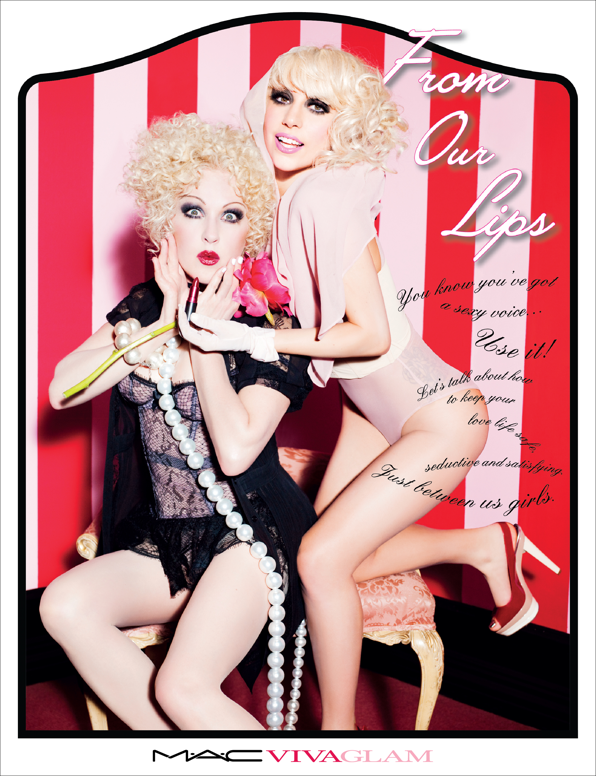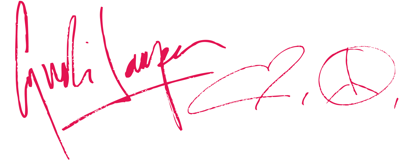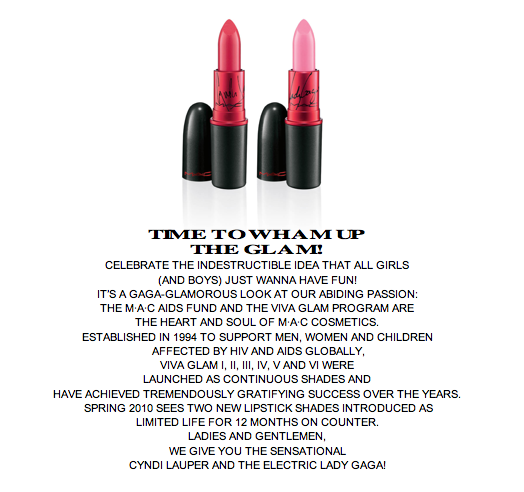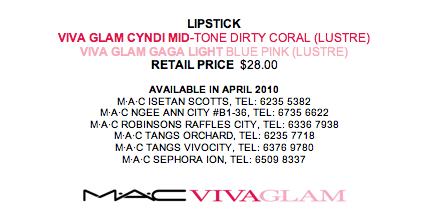This Spring, M.A.C introduces two new exciting spokespersons for two new limited edition Viva Glam lipsticks and they join a list of illuminaries who have been past spokespersons, such as Ru Paul, KD Lang, Elton John, Pamela Anderson, Missy Eliot, Mary J Blige, Christina Aguilera, Linda Evangelista and more.
The two new spokespersons are Lady Gaga and Cyndi Lauper with the lipsticks named after them : Viva Glam Gaga and Viva Glam Cindy.
 PHOTOGRAPHER: Ellen von Unwerth
PHOTOGRAPHER: Ellen von Unwerth
The new femmes of VIVA GLAM want to encourage conversation about the kind of relationships women want to have, and how to keep it safe, seductive and satisfying. From Our Lips focuses on global HIV hot spots, including South Africa, the United States’ rural South, and Washington, D.C. It supports programs in regions that are confronting the complicated causes of HIV infection in women and girls: Violence, discrimination and unequal access to financial and social resources.
All proceeds from the sales of Viva Glam products go to this cause. Neither M.A.C. nor retailers take a cut from these proceeds.
(Note: Both products are out of stock for the time being. Check back here to find out when the stocks are back)
ABOUT THE M·A·C AIDS FUND
The M·A·C AIDS Fund, the heart and soul of M·A·C Cosmetics, was established in 1994 to support men, women and children affected by HIV/AIDS globally. MAF is a pioneer in HIV/AIDS funding, providing financial support to organizations working with underserved regions and populations. As the largest corporate non-pharmaceutical giver in the arena, MAF is committed to addressing the link between poverty and HIV/AIDS by supporting diverse organizations around the world that provide a wide range of services to people living with HIV/AIDS. To date, MAF has raised over $150 Million (U.S.) exclusively through the sale of M·A·C’s VIVA GLAM Lipstick and Lipglass, donating 100 percent of the sale price to fight HIV/AIDS. For more information, visit www.macaidsfund.org.
THE (HUSH-HUSH) ISSUE: WOMEN, AIDS & HIV
Forget the stereotypes. Women are more likely to become infected with HIV than men. While the overall rate of new HIV infections has slowed, the number of women infected with HIV is growing. And in every part of the world. In sub-Saharan Africa, six out of every ten adults living with HIV are women and, even more disturbing – three out of four young people between the ages of 15-24 are infected. In the United States, where there are far more resources for HIV prevention and care, the number of women living with HIV has tripled since 1985; more African American women between the ages of 18-35 die from AIDS than from any other illness.
Now is the time to make a difference for women.
WHY WOMEN?
Simply said, women are more vulnerable – financially, socially, biologicaly. Women tend to have less social and financial power in their relationships with men, compromising their abilities to negotiate safer sex and fueling the exchange of sexual favors for money and other forms of support. In addition, because of the biological structure of women’s bodies, they are two times as likely to acquire HIV as a result of having unprotected sex with an infected man as men are with infected women. And we now know from new research that HIV attacks women’s bodies more quickly and harshly than it does men, with more devastating effects.
Sadly, funding, programs and action are not keeping pace with this growing epidemic of HIV among women. Only about half (53%) of countries report budget allocations specifically devoted to HIV-related programs for women. And the formal and informal community networks that have helped to curb HIV infection in some areas are now losing some of their most vibrant supporters.










